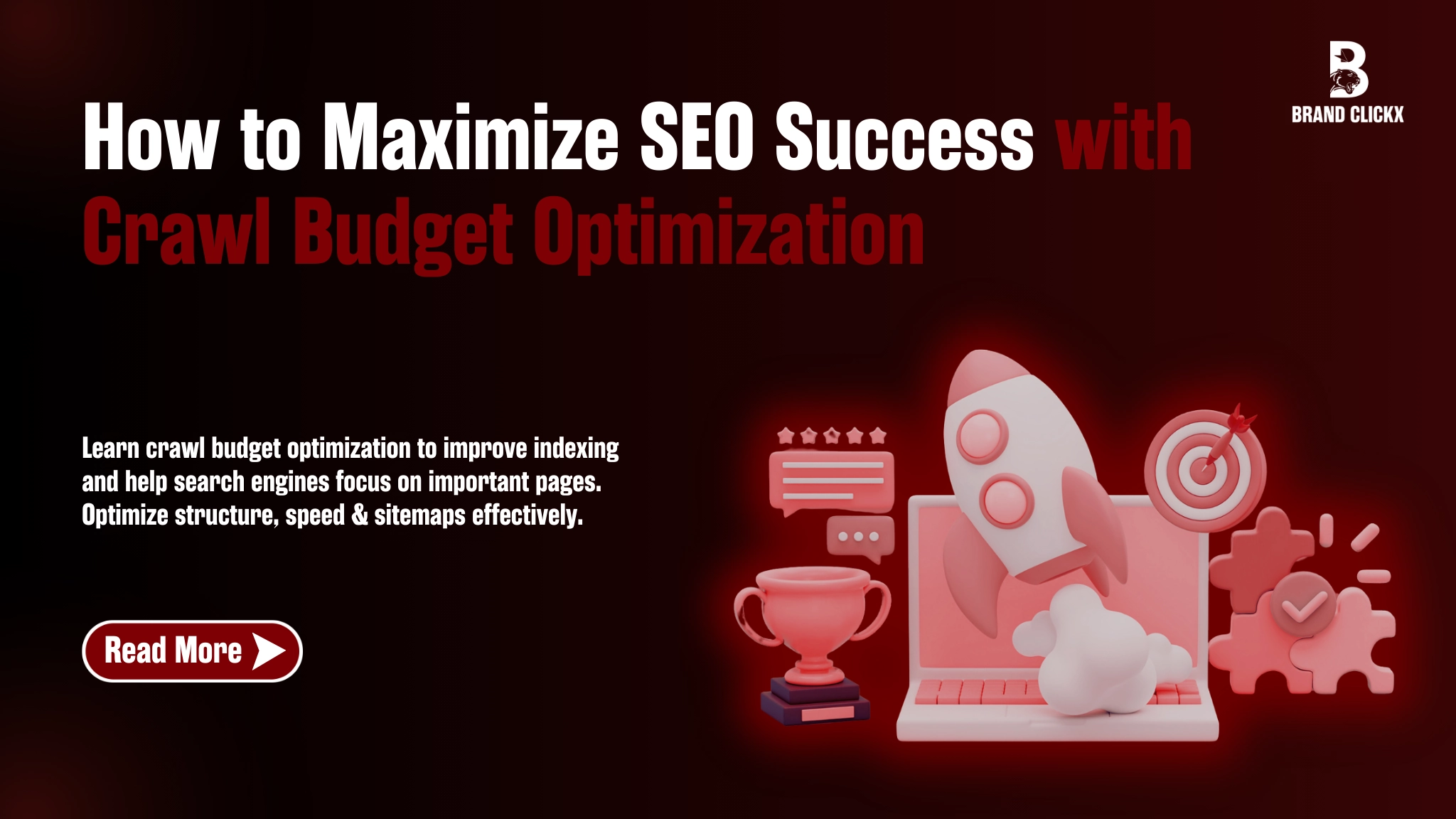Search engines don’t crawl every page equally. They allocate a crawl budget, the number of pages they crawl within a given timeframe.
Important pages may stay undiscovered if your site isn’t optimized, hurting rankings. A wasted crawl budget means search engines spend time on irrelevant, duplicate, or low-value pages instead of indexing key content.
Slow loading speeds, poor internal linking, and technical errors can block effective crawling. Crawl budget optimization helps search engines find, index, and rank your best pages faster. This means:
- Better Visibility
- Higher traffic
- stronger SEO
In this blog, we’ll explain crawl budget in detail, the factors affecting it, and proven strategies for optimizing it.
What is Crawl Budget
The crawl budget is the number of pages a search engine crawls on your website in a set time. Search engines (like Google) don’t crawl every page at once.
They choose which pages to crawl first. If your crawl budget isn’t optimized, important pages will get ignored, and your search rankings will suffer.
What Affects Crawl Budget

Several things impact how search engines crawl your site:
- Website Size – Larger sites need better crawl management.
- Page Quality – Fresh content gets crawled more.
- Website Speed – Faster sites allow more pages to be crawled.
- Internal Links – Well-connected pages are easier to find.
- Duplicate Pages – Duplicate content wastes crawl budget.
- Server Health – Downtime or slow servers reduce crawling.
- Blocked Pages – Robots.txt and noindex tags can stop pages from being crawled.
How Do Search Engines Decide What to Crawl
Search engines use two main things:
- Crawl Demand – Popular or frequently updated pages get crawled more.
- Crawl Capacity – Search engines will crawl more pages if your site loads fast and works well.
By managing these, you can help search engines focus on the most important pages and increase your rankings and traffic.
Best Practices for Crawl Budget Optimization

Below are the best practices to maximize your crawl efficiency.
1. Improving Website Architecture
A well-structured website makes it easier for search engines to discover and crawl pages efficiently.
Logical and Clear Internal Linking
Internal links act as pathways for search engines. A well-connected website helps bots find important pages faster. Use descriptive anchor text and link to relevant pages naturally.
Reducing Deep Pages in the Structure
If a page requires too many clicks to reach from the homepage, search engines may struggle to crawl it. To improve accessibility, keep key pages within three clicks from the homepage.
On our Brand ClickX website, we have minimized the crawl depth to just two clicks. All main navigation items are at the top, making it easy to find relevant sections quickly.

Read More:
- Writing Pillar Content For SEO Success and Rankings in 2025
- Optimizing website architecture for lead nurturing
2. Eliminating Low-Value Pages
Search engines may waste the crawl budget on pages that add no value. Removing them can improve efficiency.
Removing Thin or Duplicate Content
Pages with little or no original content (like tag pages, auto-generated pages, or excessive search results) can reduce crawl efficiency. Remove, merge, or improve such pages.
Using Proper Canonical Tags
If you have similar pages (e.g., product variations), use the <link rel=”canonical”> tag to point search engines to the main version, preventing duplicate content issues.

3. Optimizing Robots.txt & Noindex
Control what search engines crawl by properly using robots.txt and noindex tags.
Blocking Unnecessary Pages from Being Crawled
Some pages (like admin panels, login pages, thank-you pages) don’t need to be indexed. Use robots.txt to disallow them from being crawled.
Handling Pagination and Filtered Pages
Pagination (page=2, page=3 URLs) and filter-based URLs (?color=red) can generate endless duplicate pages. Use canonical tags or nofollow attributes to prevent crawl waste.
4. Enhancing Website Speed & Performance
A slow-loading website limits how many pages search engines can crawl in one session.
Optimizing Server Response Time
If your server is slow, search engines will reduce the frequency of your crawls. Use a reliable hosting service and optimize database queries to improve response time.
Reducing Page Load Time
Faster pages allow search engines to crawl more pages per visit. Reduce load times by:
- Compressing images
- Using lazy loading
- Enabling browser caching
- Reducing unnecessary scripts
5. Managing XML Sitemaps Efficiently
An XML sitemap is a roadmap for search engines, ensuring they discover essential pages.
Keeping Sitemaps Updated and Clean
Make sure your sitemap only includes active, indexable pages. Remove outdated, redirected, or noindex pages.
Prioritizing Important Pages
Place high-value pages (such as main service, product, and blogs) in the sitemap to ensure they get crawled first.
6. Fixing 404 Errors and Broken Links
Search engines may stop crawling your site if they encounter too many broken links. Regularly check and fix 404 errors using tools like Google Search Console.

Monitoring and Measuring Crawl Budget Optimization
After applying these strategies, monitoring how search engines crawl your website is crucial.
1. Check Google Search Console Crawl Stats
Google Search Console provides a Crawl Stats Report, showing:
- How many pages does Google crawl daily
- Crawl errors (like 404s, blocked pages)
- Server response times
Regularly checking this report helps you spot issues before they impact rankings.
2. Analyzing Log Files for Bot Behavior
Log files show how search engine bots interact with your site. By analyzing logs, you can:
- Identify which pages Google crawls most often
- Spot unnecessary pages being crawled
- Detect slow response times

3. Identifying Crawl Anomalies and Fixes
Look for patterns like:
- Google crawling unimportant pages → Block them via robots.txt
- Important pages not being crawled → Improve internal linking and sitemap
- A sudden drop in crawls → Check for server or robots.txt issues
Monitor your crawl budget to ensure search engines focus on important pages. This improves rankings and boosts traffic.
FAQs
1. How to optimize your crawl budget?
To optimize your crawl budget:
- Improve website speed to allow faster crawling.
- Fix broken links and eliminate redirect chains.
- Remove duplicate, thin, or low-value pages.
- Optimize internal linking for better navigation.
- Manage robots.txt and XML sitemaps efficiently.
2. What is my crawl budget?
It’s the number of pages search engines crawl on your site within a given time. Google decides this based on factors like:
- Site authority
- Structure
- Server Performance.
3. What is the crawl budget formula?
Crawl Budget = Crawl Rate Limit × Crawl Demand
- Crawl Rate Limit: The maximum number of requests a search engine makes to your site.
- Crawl Demand: How often do search engines want to crawl your pages?
A well-optimized site increases both factors, improving crawl efficiency.
Final Words
Crawl budget optimization helps search engines focus on your website’s top pages. A well-organized site with fast loading times, proper internal linking, and minimal errors means better indexing and higher rankings.
Monitor through Google Search Console and log file analysis to catch crawl issues before they impact your traffic.
Need help with your website’s crawl efficiency? Get in touch today and boost your visibility!



